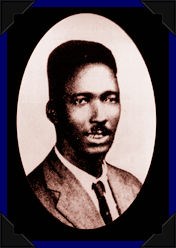
Tommy Johnson was born circa 1896, on George Miller's Plantation near Terry, Mississippi, twenty miles south of the state capital of Jackson. One of thirteen children, Tommy and his family moved to Crystal Springs, Mississippi, around 1910. The Johnsons were a musical family. Tommy's uncle and brothers Mager and LeDell played guitar, while other relatives played in a brass band. LeDell taught Tommy the rudiments of guitar about 1910, and by 1914 the Johnson brothers were supplementing their sharecropping incomes by playing parties in the Crystal Springs area.
In 1916, Tommy Johnson married Maggie Bidwell and the couple moved to Webb Jennings's Plantation near Drew, in Mississippi's Yazoo Delta region close to Dockery's Plantation. Although Johnson would have several wives, it was his first whom he later immortalized in the song "Maggie Campbell Blues." Johnson soon fell under the spell of Dockery resident Charley Patton and local guitarists Dick Bankston and Willie Brown. He lived there for a year, learning the nuances of the Delta style before moving on to hobo around Arkansas, Louisiana, and Mississippi. Johnson, now an alcoholic and womanizer, moved back to Crystal Springs in 1920, resuming his musical partnership with Mager and LeDell. He also returned to life as a sharecropper, playing at parties on the weekends or on the streets of Jackson and nearby towns for tips. During the fall cotton harvest season, Johnson traveled back to the Delta, playing for sharecroppers who had just been paid. During the early 1920s he gigged with Charley Patton in Greenwood and nearby Moorehead. The latter is famous for its railroad crossing Where the Southern Crosses the Dog, heralded in W.C. Handy's "Yellow Dog Blues."
Johnson cut his first records with guitarist Charlie McCoy in February 1928 at the Memphis Auditorium for the Victor label. These sides sold well enough to prompt a follow-up session in August of that year. That session yielded the notorious "Canned Heat Blues," in which he admitted to drinking Sterno to satisfy his alcohol cravings. The theme of alcoholism would be touched upon again in "Alcohol and Jake Blues," waxed during his final recording session for the Paramount label in December 1929. Johnson traveled to Paramount's studio in Grafton, Wisconsin, where Delta luminaries Son House, Skip James, and Charley Patton had also recorded. After the onset of the Great Depression, the enthusiasm of the record-buying public lessened and Johnson was not invited to record further.
Johnson's recordings showcased an eerie falsetto and masterfully manipulated vocal dynamics that established him as the premier Delta blues vocalist of his day. His facile guitar playing, rhythmic and solid, was secondary to his exceptional singing. Echoes of Johnson's vocal style, notably on "Cool Drink of Water Blues," can be heard in Howlin' Wolf's delivery. Johnson's influence passed from musician to musician: bluesman Houston Stackhouse taught fledgling guitarist Robert Nighthawkseveral Tommy Johnson numbers.
To enhance his fame, Johnson cultivated a sinister persona similar to that of St. Louis bluesman Peetie Wheatstraw, the self-styled "Devil's son-in-law." His brother LeDell later said that Tommy claimed to have made a pact with Ol' Scratch at the crossroads, a subject later touched upon by bluesman Robert Johnson (no relation). Adding further eccentricity to his conjurer image, Johnson carried and displayed a large rabbit's foot. Another distinction, perhaps borrowed or picked up from Patton, was a proclivity for "clowning" with his guitar. Even after his death, Johnson was remembered for playing the guitar between his legs like he was riding a mule, playing it behind his head, tossing the guitar up in the air, and other acrobatic antics. Johnson spent the rest of his years in Crystal Springs and remained a popular performer in the Jackson area through the 1940s.
Tommy Johnson died of a heart attack after playing a party on November 1, 1956. He is buried in the Warm Springs Methodist Church Cemetery in Crystal Springs, Mississippi.
Music Samples
Last updated: October 25, 2017
